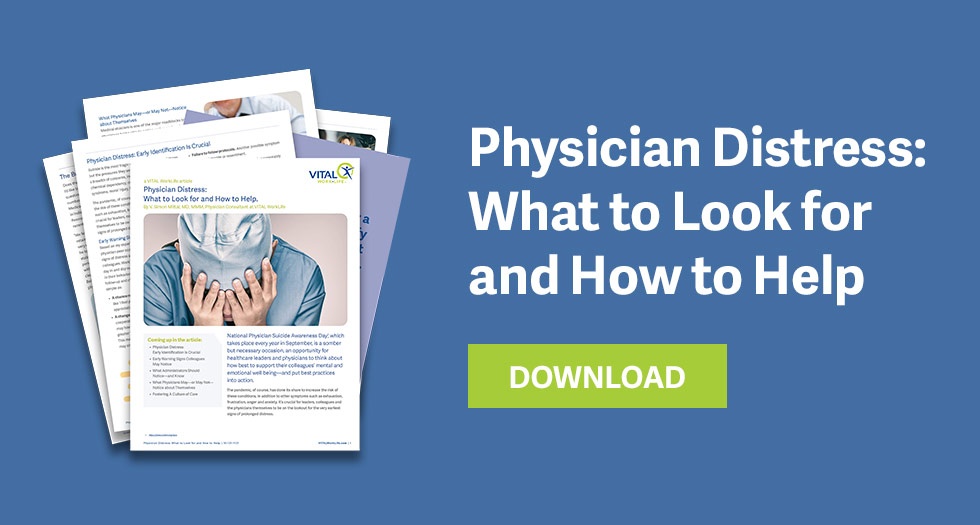The pressures physicians work under today are many, any of which could put their well being at risk. Fortunately, there are many responses organizations and individuals can take to mitigate that risk, in particular, by looking for early warning signs of distress.
 The traditional intensities of medicine have been amplified by factors connected with 21st century developments—like the increasing tendency of physicians to be employees of large healthcare organizations, perceived loss of autonomy, time consuming bureaucratic tasks and digital coding, an aging patient population with increasingly complex conditions—and have been compounding the effects on physician well being for many years.
The traditional intensities of medicine have been amplified by factors connected with 21st century developments—like the increasing tendency of physicians to be employees of large healthcare organizations, perceived loss of autonomy, time consuming bureaucratic tasks and digital coding, an aging patient population with increasingly complex conditions—and have been compounding the effects on physician well being for many years.
And then there’s the pandemic—a crisis unprecedented in over a hundred years.
Healthcare organizations have been turning to solutions like those VITAL WorkLife offers to meet mental and behavioral health challenges like:
Depression. “Depression (major depressive disorder),” says the American Psychiatric Association, “is a common and serious medical illness that negatively affects how you feel, the way you think and how you act. Depression causes feelings of sadness and/or a loss of interest in activities you once enjoyed. It can lead to a variety of emotional and physical problems and can decrease your ability to function at work and at home.”
Burnout. Defined by the World Health Organization as “a syndrome conceptualized as resulting from chronic workplace stress that has not been successfully managed. It is characterized by three dimensions: feelings of energy depletion or exhaustion; increased mental distance from one’s job, or feelings of negativism or cynicism related to one's job; and reduced professional efficacy.”
Compassion fatigue. According to Charles R. Figley, PhD, founder of the Traumatology Institute at Tulane University, compassion fatigue occurs when physicians take on the suffering of patients who have been severely stressed or traumatized and represents the psychological cost of healing others.
Chemical dependency. Also termed substance dependence, it’s explained by Johns Hopkins Medicine as “abuse of drugs or alcohol that continues even when significant problems related to their use have developed.”
Second victim syndrome. Second victims are “healthcare providers who are involved in an unanticipated adverse patient event, medical error and/or a patient related injury and become victimized in the sense that the provider is traumatized by the event,” according to the Center for Patient Safety.
Moral injury. Wendy Dean, MD Simon Talbot, MD and Austin Dean describes how moral injury manifests in their article Reframing Clinician Distress: Moral Injury Not Burnout as, “Moral injury occurs when we perpetrate, bear witness to, or fail to prevent an act that transgresses our deeply held moral beliefs.” They go on to explain that physicians take the oath to put the needs of patients first, but are increasingly forced to consider the demands of other stakeholders in their daily practice, such as insurers, EMRs, or the healthcare system they work for. And through repetitive instances when they are forced to make a decision that contravenes their patients’ best interest, it ultimately leads to moral injury.
PTSD. “A psychiatric disorder,” says the American Psychiatric Association, “that may occur in people who have experienced or witnessed a traumatic event. People with PTSD have intense, disturbing thoughts and feelings related to their experience that last long after the traumatic event has ended. They may relive the event through flashbacks or nightmares; they may feel sadness, fear or anger; and they may feel detached or estranged from other people.”
Suicidal ideation. Medical News Today: “Suicidal thoughts, or suicide ideation, refers to thinking about or planning suicide. Thoughts can range from creating a detailed plan to having a fleeting consideration. It does not include the final act of suicide.”
These are serious issues—but there are many effective countermeasures you can take to protect the well being of your staff. Our article Physician Distress: What to Look for and How to Help presents detailed measures for spotting physician distress before it worsens into one of these conditions, along with how to build a culture of care in the organization to make early intervention a standard procedure.



